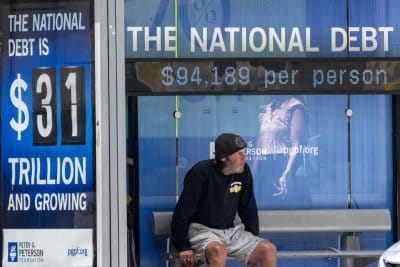Contributor: The U.S. credit downgrade is not the problem. Our reckless spending is
America’s debt-addicted government just lost its triple-A credit rating from Moody’s, as it previously had from fellow rating agencies S&P and Fitch. Many in Washington shrugged the move off as minor or as unfair treatment of the Trump administration. The truth is more sobering: a flashing red signal that the United States is no longer seen as a “perfect” credit risk and that politicians should stop pretending economic growth alone can bail us out.
Yes, the mess is real, and it’s because habitual deficit financing — the very disease fiscally minded founding father Alexander Hamilton warned against — has become business as usual.
The reckoning comes as House Republicans push to extend the 2017 Trump tax cuts with a “big, beautiful bill.” If handled correctly, it’s a good idea. But while the legislation aims to avoid tax hikes, it pairs modestly pro-growth provisions with a smorgasbord of costly special-interest giveaways. Worse, it assumes we can afford yet another $3 trillion to $5 trillion in debt without serious consequences. That’s the kind of magical thinking that spurred the credit downgrade.
Starting with Hamilton, American politicians long understood the importance of fiscal policy guided by the ethos of balanced budgets, low taxes and steady debt reduction. Their vision, combined with a deep respect for contractual repayment and financial responsibility, made America a creditor nation.
Washington abandoned that honorable legacy in recent decades. U.S. national debt held by the public is racing toward $30 trillion, and the cost of servicing it is ballooning. Interest payments are now one of the fastest-growing parts of the budget — $1 trillion in 2026 — crowding out core priorities and leaving us vulnerable to economic shocks. The Congressional Budget Office warns that even modest interest-rate increases could lead to hundreds of billions of dollars in added annual costs. It’s not a theoretical problem; it’s a real, compounding threat.
Which brings us back to the downgrade. Historically, downgrades like those from S&P in 2011 or Fitch in 2023 haven’t caused immediate crises, but they do raise borrowing costs and gradually erode investor confidence. The downgrades are not the problem, but symptoms of a deeper illness: lack of credible fiscal discipline. Market participants aren’t worried because Moody’s wrote a negative report; they’re worried because what Moody’s wrote is true.
If our political class continues to ignore warnings, the market will do what rating agencies only hint at: impose real discipline through higher borrowing costs, weaker currency demand and tighter credit conditions. Already, China and other countries have reduced holdings of U.S. Treasuries from 42% in 2019 to 30% today.
Meanwhile, the tax plan so far embodies Washington’s worst habits. It makes only temporary the most important pro-growth provisions of the 2017 tax cuts — like full expensing for equipment and research and development — while rendering permanent a raft of unrelated policies catering to favored industries and constituencies. That’s not tax reform; it’s pork-barrel politics dressed up as populist economics.
Worse still, the bill’s Republican supporters in the House justify it with the fantastical claim that it’s fiscally responsible based on the notion that it will raise trillions in growth-generated revenue. Even the most optimistic models show the current bill barely moving the growth needle. The administration claims growth will be enormous once it deregulates and sells off assets, but these distinct policies take a long time to bear fruit.
What a missed opportunity. According to Tax Foundation experts, making just four cost-recovery provisions permanent — bonus depreciation, R&D expensing, full expensing for factories and reforming the business-interest limitation — would more than double the tax bill’s long-run growth benefits.
That’s where legislators should be focused. Not on tax breaks for hand-picked industries or energy credits for hand-picked technologies — on structural reforms that maximize American investment, innovation and capital formation. Even such pro-growth tax policy must be paired with real spending restraint, something we haven’t seen in earnest since the 1990s. Otherwise, any gains from better tax policy will have red ink spilled all over them.
The lesson from Moody’s, and from history, is that America cannot borrow its way to prosperity. That was Treasury Secretary Andrew Mellon’s view in the 1920s, and it remains true today. Mellon quietly prepared for debt defaults by building budget surpluses, knowing that while international repayments might fail, American citizens still had to be paid. That was back when Treasury secretaries respected taxpayers.
Now, as then, we stand at a crossroads. Will we restore Hamiltonian principles of fiscal prudence or continue down a path where downgrades become defaults and our creditors decide the terms of American fiscal policy? The next move belongs to Congress. Legislators can’t say they weren’t warned. If they fail the fiscal prudence test again, we’ll all pay the price.
Veronique de Rugy is a senior research fellow at the Mercatus Center at George Mason University. This article was produced in collaboration with Creators Syndicate.


